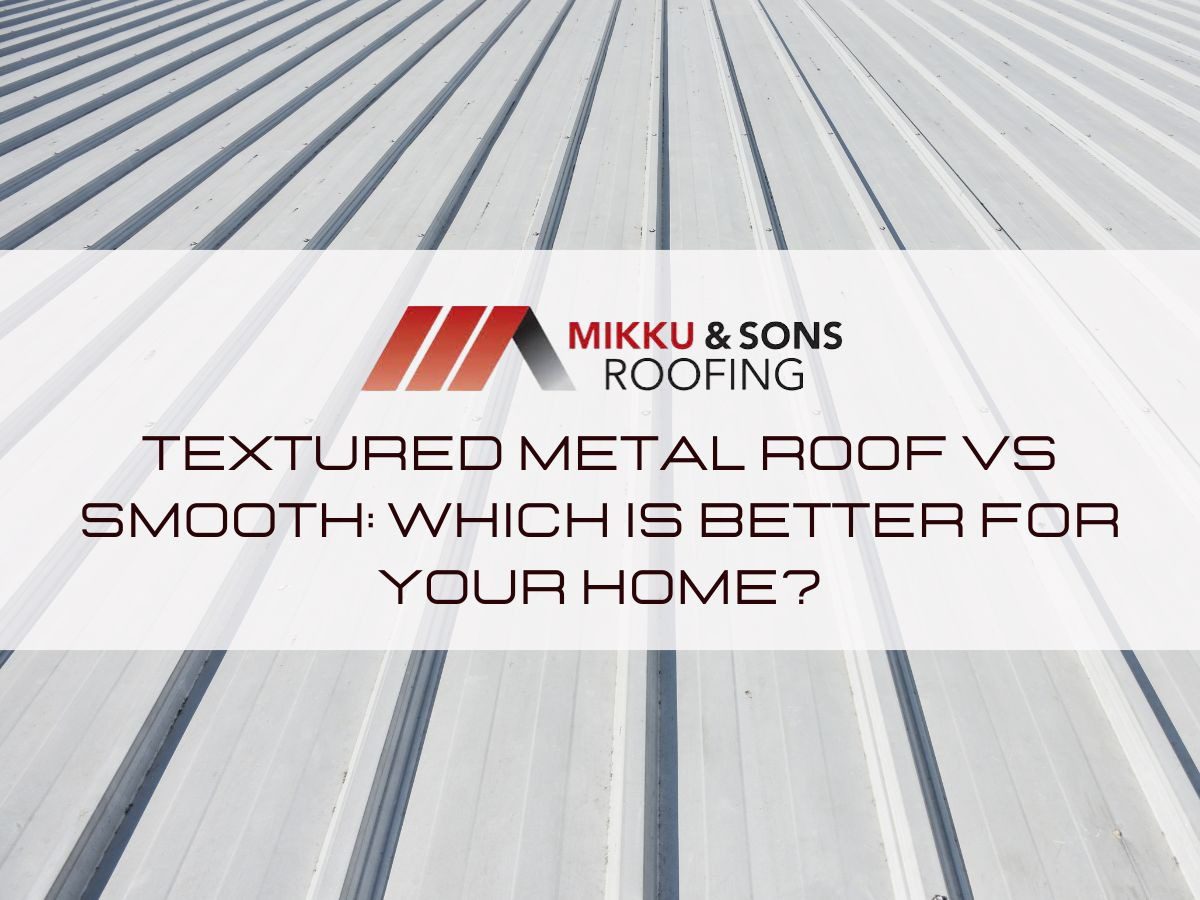
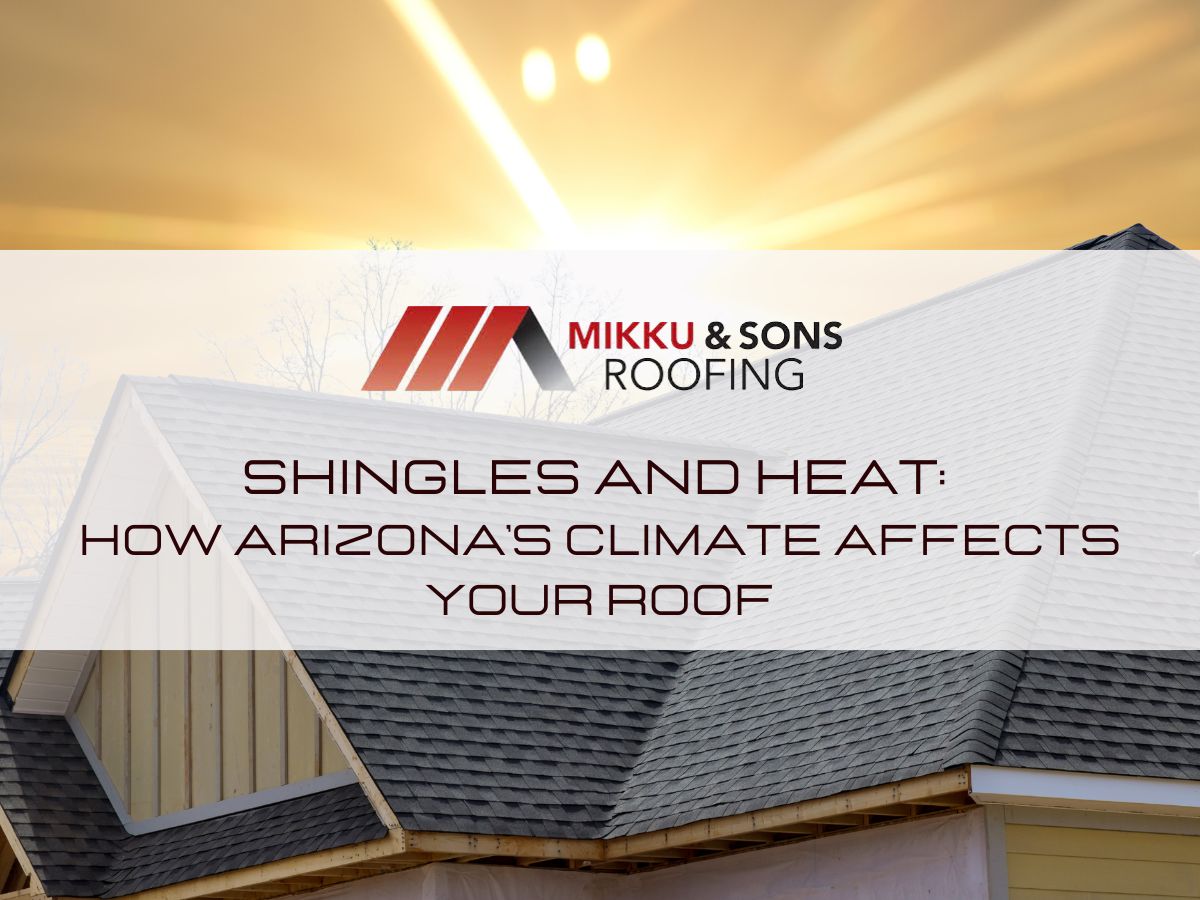
Arizona's intense heat and sun-soaked days shape nearly every aspect of residential living, from landscaping choices to cooling strategies. One of the most heavily impacted elements of any home in this desert state is the roof.
In particular, asphalt shingles, which are common roofing materials, face challenges unique to the arid, scorching environment. With temperatures frequently soaring above 100°F during summer months, the longevity and performance of roofing systems come under significant stress.
High thermal loads can cause structural changes in roofing materials, which over time lead to curling, cracking, and premature degradation. Compromised shingles increase the risk of water infiltration, insulation damage, and elevated cooling costs. How does Arizona’s climate affects your roof? How do shingles and heat relate? Let's find out.
Asphalt shingles are particularly susceptible to heat-related deterioration. Arizona's climate worsens the natural aging process, often shortening the expected lifespan of these shingles by several years.
Constant exposure to ultraviolet radiation and high ambient temperatures triggers chemical changes within the asphalt binder, reducing its flexibility and making it more brittle over time.
UV rays act as an aggressor, gradually degrading the asphalt and the protective granules embedded within the shingle surface. As granules detach, the underlying asphalt becomes more exposed and vulnerable to heat and weathering.
This accelerates the breakdown process, making shingles more prone to cracks and surface blisters, especially on sun-facing slopes of the roof.
Arizona’s dramatic diurnal temperature shifts, where daytime heat is followed by much cooler nights, can cause repeated cycles of expansion and contraction in roofing materials. Over time, this movement weakens the integrity of shingles, leading to edge curling, splitting, and loss of adhesion.
These mechanical failures not only reduce the roof's durability but also open pathways for moisture penetration during monsoon season.
When shingles deteriorate, the risks extend beyond visible damage. The structural components of the roof, including decking and underlayment, are exposed to greater stress.
Water intrusion becomes a significant concern, particularly during Arizona's summer storms, which can bring heavy rainfall in short bursts. Even small leaks can lead to mold growth and insulation degradation if not promptly addressed.
Damaged shingles also contribute to increased interior temperatures. Without a fully intact roofing barrier, homes absorb more heat, forcing air conditioning systems to work harder.
This results in higher energy bills and reduced HVAC system lifespan. Roofing that reflects more sunlight and insulates against heat transfer, such as light-colored shingles or those with reflective coatings, can significantly reduce these cooling loads.
Proper attic ventilation and insulation work hand-in-hand with roofing materials to manage heat. Inadequate airflow traps hot air within the attic space, compounding the thermal stress on shingles.
Investing in ventilation upgrades, such as ridge vents or attic fans, helps regulate attic temperatures and enhances overall roof performance.
Selecting roofing shingles in Arizona is a decision that has long-term implications for energy efficiency, durability, and overall home protection. The intense solar radiation, frequent thermal cycling, and occasional severe weather mean that not all shingle types will perform equally.
Homeowners must evaluate materials based on how well they resist heat, reflect sunlight, endure storm conditions, and integrate with proper ventilation and installation methods.
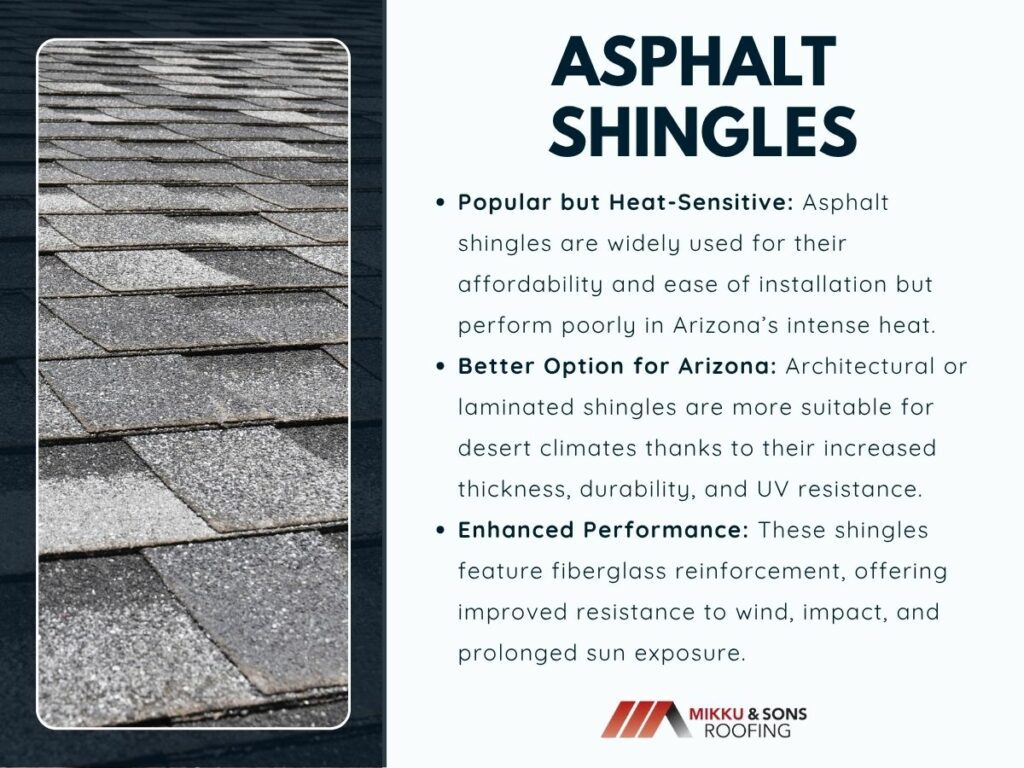
Asphalt shingles are the most commonly used roofing material in the United States, including Arizona, largely due to their affordability and ease of installation. However, traditional three-tab asphalt shingles are not always ideal for desert climates.
They tend to absorb and retain heat, which can accelerate the aging process under Arizona’s relentless sun. To increase their suitability, Arizona homeowners should opt for architectural or laminated asphalt shingles, which are thicker, more durable, and more resistant to UV damage.
These shingles typically feature multiple layers of asphalt with fiberglass reinforcement, offering better wind and impact resistance.

Cool roof shingles are engineered to reflect more sunlight and absorb less heat than standard roofing materials. By reducing surface temperatures, these shingles help to lower attic heat gain and lessen the burden on air conditioning systems.
Manufacturers like Owens Corning, CertainTeed, and GAF offer Energy Star-rated shingles with solar-reflective properties. These products often include advanced coatings or highly reflective granules that deflect UV rays and slow material degradation.
Although cool roof shingles may cost more initially, the long-term savings in energy consumption and the extended lifespan often offset the upfront investment.

Metal shingles and standing seam metal roofing offer exceptional performance in high-temperature environments. These systems are designed to reflect solar radiation effectively, reducing rooftop temperatures by up to 50°F in some cases.
Metal does not degrade under UV exposure like asphalt, and modern coatings prevent rust and fading even in arid conditions. While metal roofing is more expensive upfront, its longevity, often 40 to 70 years, and minimal maintenance requirements make it a practical option.
Additionally, metal roofs are resistant to fire, wind, and hail, providing superior protection during Arizona’s monsoon season.

Clay and concrete tile roofs are iconic in Arizona’s southwestern architecture for good reason. These materials are inherently resistant to UV radiation and thermal cycling.
Their mass helps stabilize temperature swings, and their curved shapes facilitate airflow beneath the tile, naturally cooling the roof structure. Tiles also perform well in monsoon conditions, resisting wind uplift and shedding water efficiently.
Clay tiles and concrete tiles are significantly heavier than shingles and require reinforced roof structures to support their weight.
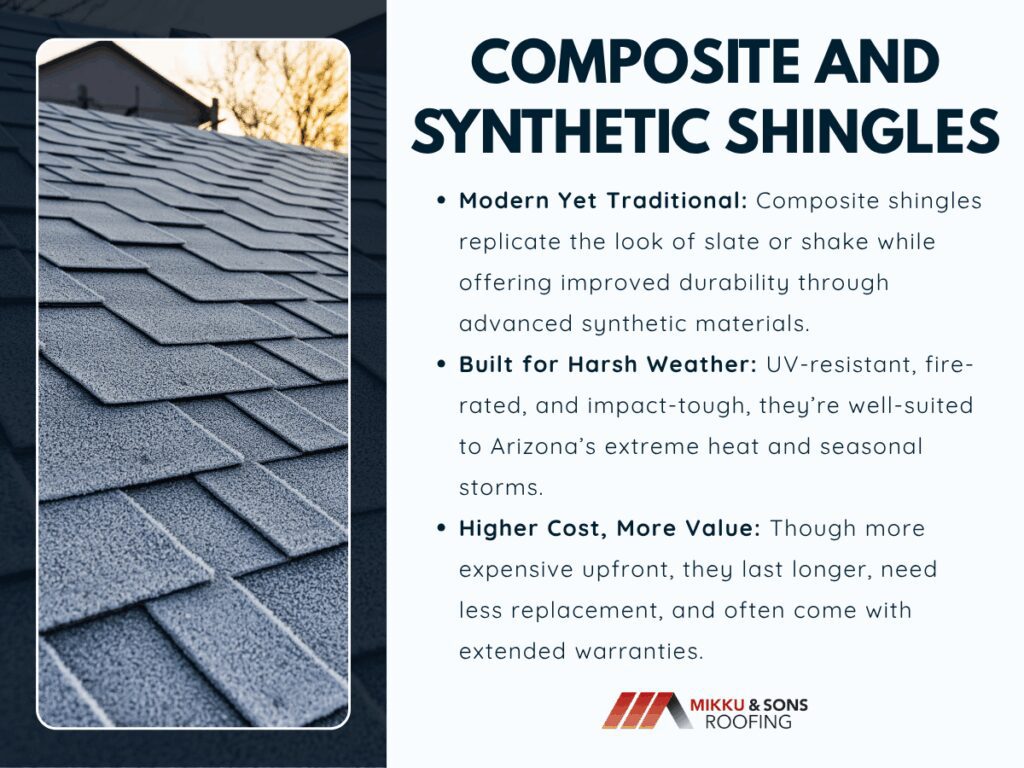
Composite shingles made from synthetic polymers offer a balance between the aesthetic appeal of natural materials and the performance benefits of modern engineering. Brands like DaVinci and Brava produce shingles that mimic the appearance of slate or shake but weigh less and offer greater resilience in harsh climates.
These products are UV-resistant, fire-rated, and capable of withstanding high winds and impacts, making them an increasingly popular choice in Arizona. Although synthetic shingles come with a higher price tag, they require less frequent replacement and generally include extended manufacturer warranties.
They also tend to perform well in both high temperatures and during sudden weather events.
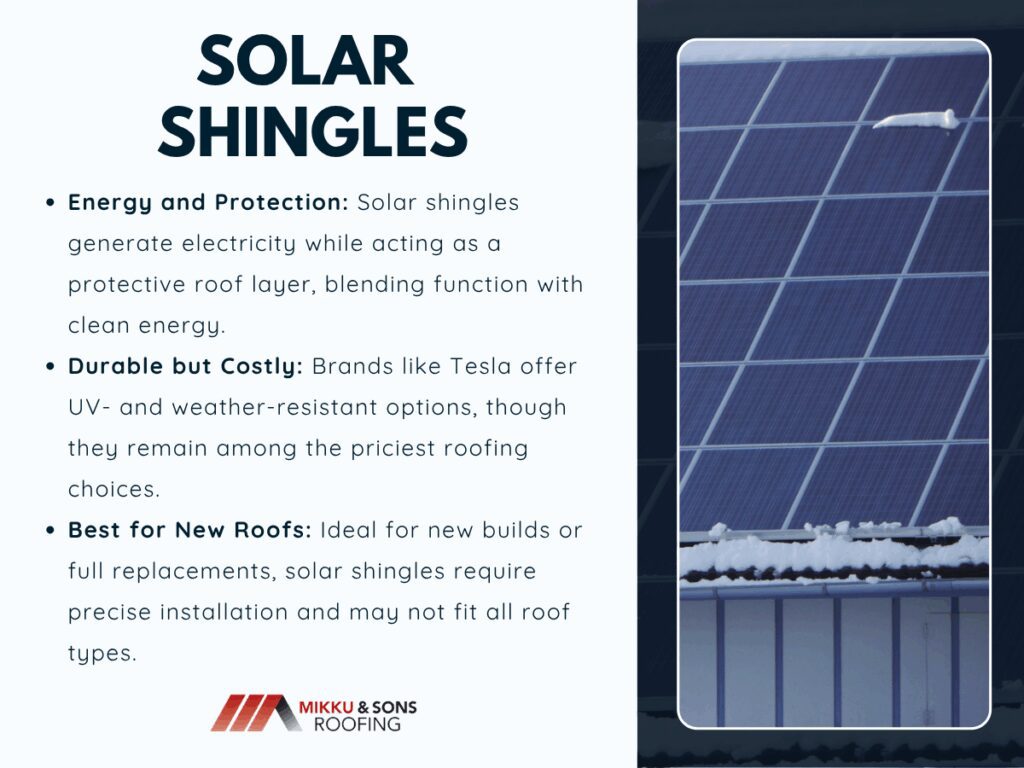
For those interested in combining renewable energy with functional roofing, solar shingles present a futuristic solution. Unlike traditional panels that sit atop the roof, solar shingles are integrated into the roof surface, generating electricity while protecting the home.
Brands like Tesla and CertainTeed offer solar roofing products designed to withstand harsh weather and UV exposure. However, they remain one of the most expensive roofing options and may not be suitable for every roof style or pitch.
Proper installation is crucial, and these systems are best suited for new builds or full roof replacements rather than retrofits.
The extreme conditions in Arizona accelerate wear on all types of roofing systems, particularly asphalt shingles. The upfront investment in durable materials and expert installation is important, and so is the longevity and effectiveness of any roof.
Thoughtful, consistent care can help prevent minor issues from becoming costly repairs and ensure your roof performs optimally for decades.
Arizona homeowners should conduct inspections twice a year: once in late spring before summer temperatures peak, and again in early fall after monsoon season. During these inspections, look for cracked, curled, or missing shingles, loose flashing, degraded sealants around vents and chimneys, and exposed underlayment.
Pay close attention to any areas that seem discolored, which could indicate trapped moisture or heat damage. In addition to visual inspections from the ground or a ladder, consider using binoculars or drone footage to examine hard-to-reach sections of the roof.
This method can reveal damage around skylights, dormers, or valleys that would otherwise go unnoticed.
Arizona’s dry climate means less organic buildup than in more humid regions, but wind-blown debris still presents a problem. Twigs, leaves, dust, and sand can accumulate in valleys and around roof penetrations, especially after monsoon storms.
These materials trap moisture during rain events and create conditions where mildew and algae can grow, even in desert conditions. Set a schedule for gently removing debris using a soft broom or air blower.
Avoid using pressure washers or scraping tools, which can dislodge protective granules from the shingles or damage flashing. Don’t forget to clear gutters and downspouts, which are critical for redirecting water off the roof and away from the foundation.
The effects of thermal cycling; daily expansion and contraction from extreme temperature swings; can go unnoticed until major damage occurs. Over time, this stress can loosen nails, warp shingles, and separate seams.
Homeowners should periodically check for these signs of movement, particularly after summer heat waves or significant temperature fluctuations. Inspect for small separations or lifting at shingle edges, which may allow water to infiltrate the underlayment.
Look for nail pops (raised nails protruding from shingles), which can compromise the roof’s waterproof barrier. Structural areas around chimneys, skylights, and vents should also be closely examined, as these are common failure points due to shifting materials and weakened seals.
In Arizona’s harsh climate, sealants and caulking dry out and crack much faster than in temperate zones. This deterioration can create tiny openings that allow water ingress during a storm or monsoon event.
Regularly inspect and refresh caulking around roof vents, chimneys, skylights, satellite mounts, and HVAC components. Use high-quality, UV-resistant sealants that can withstand the heat without softening or cracking prematurely.
If existing sealant shows signs of shrinkage, brittleness, or detachment, it should be removed and replaced rather than layered over, which can mask underlying problems.
Arizona’s extreme weather patterns place extraordinary demands on roofing systems. Materials that perform well in other parts of the country often fall short in Arizona unless they are specifically engineered or selected with the desert climate in mind.
Smart homeowners evaluate roofing options through a climate-specific lens and provide structural integrity during both scorching summers and sudden storms. It can be by investing in reflective cool roof shingles, durable metal systems, traditional clay tiles, or high-tech solar shingles
Just as vital is working with local roofing professionals who understand the challenges of Arizona construction and can ensure proper installation and ventilation.
